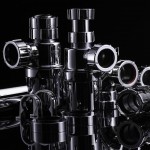
History tends to repeat itself when it comes to the selection of cryogenic valves in LNG applications, which can result in outdated choices and inappropriate valve usage. Bestobell Valves’ Technical Director Kevin Fretwell looks at the key factors in choosing the right valve for the job.
Recent advances in valve design offer major improvements for the LNG industry. Too often, cryogenic valve selection is based on history
– it worked reasonably well last time so let’s use it again – but technical advances mean historical decisions may no longer be best.
There are four alternative types of cryogenic isolation valve suitable for LNG application – globe, gate, ball and butterfly. Each has its own particular set of characteristics that must be evaluated in the context of key criteria such as safety, efficiency, reliability and cost.
Globe valves
Globe valves (Above right) are so called because of their spherical body shape, but the name is used to describe any valve that has the same internal working principle – a movable disc (obturator) that moves at 90° to the plane of its mating body seat.
Due to the fine control that can be achieved with this design, globe valves are better suited to regulating and throttling service than gate or ball valves. Furthermore, because the valve disc moves directly away from its mating seat, the valve is less prone to seat damage and wear than gate or ball valves.
Globe valves have, therefore, been considered more reliable for long-term sealing performance.
However, globe valves may be less suitable if flow rate is an important consideration. Their internal shape gives greater flow resistance than gate and ball valves. Typical resistance factors are between 5 and 7 – the lower the resistance factor, the better flow characteristic.
Globe valves are also more susceptible to problems caused by moisture, which freezes on cool down and causes ice to build up inside the valve. This can stop the valve from sealing and operating correctly.
However, the Bestobell globe valve is designed with drain holes in order to alleviate this problem.
These characteristics mean globe valves are best suited for the majority of cryogenic applications where long-term reliability is required. Typical uses are on the fill lines of storage tanks – on/off or regulating – and isolating services for end of line or maintenance requirements.
Ball valves
As the name implies, the ball valve uses a ball as the obturator. The body seat is usually Polytetrafluoroethylene (PTFE), there is a port through the centre of the ball, and the valve operates with a 90° turn of the hand lever or actuator.
Ball valves have better flow characteristics than globe valves – when the valve is fully open there is a clear unobstructed flow path along the pipeline. Typical resistance factors are between 0.3 and 1.0, the higher value being for reduced port valves. Ball valves are also quick and simple to operate with
a 90° turn of the valve stem.
This makes them more suitable for automation as the 90° actuator is a low cost, readily available item.
However, due to the sliding action of the ball over the body seats, ball valves are prone to wear of the seals and ball, especially if particulate contamination is present in the line. Ball valves, then, are less suitable where tight shut-off is critical over long service life.
So where an unrestricted flow path is required and leakage at shut-off is not critical, or valve operation is infrequent, ball valves are a good choice. Typical application would be fill and isolating valves used on CO2 trailers, where the temperature is not low (-20°C).
Other uses might be as road trailer fire block valves, where the valve normally remains open until emergency shut off is required.
There are many different methods of construction for a ball valve, from three-piece to top entry. In applications where the valve must be fire-safe,
top entry valves are normally used.
The main Achilles heel of the ball valve is particulate contamination and this often occurs at the commissioning stage of new pipelines. As a result, on LNG cargo carriers for example, the present day has seen ball valves mostly replaced by globe valves.
Gate valves
The gate valve is characterised by the movement of the ‘wedge’ (obturator) being approximately parallel to the plane of the mating body seat.
Gate valves also have better flow characteristics than globe valves – when the valve is fully open there is a clear unobstructed flow path along the pipeline.
Typical resistance factors are between 0.3 and 1.0, the higher value being for reduced port valves.
However, the sliding action of the obturator over the machined body seat means that, like the ball valve, wear of the seal and seat takes place, especially if particulate contamination is present in the line. So again, like the ball valve, gate valves are less suited to situations where tight shut-off is critical over long service life.
Another important consideration is that the conventional gate valve has a metal seat machined into the body. So when damage occurs, the body must be removed from the line and, in welded installations, this means cutting the body out of the line – a difficult and costly operation.
Gate valves are typically used for road trailer pump inlet valves – sometimes actuated for emergency shut-off – where flow restriction would cause pump cavitation. They are also widely used as delivery valves on road trailers, where unrestricted flow is required to reduce fill times.
However, the Bestobell gate valve has been designed to remove many of the drawbacks associated with conventional gate valves. It offers full bore flow rates with a sealing mechanism that gives trouble-free service and easy maintenance when required.
This is achieved by providing a flexible obturator sealing disc to compensate for thermal expansion, coupled with lapped seat faces to greatly reduce seal wear.
In sizes that allow – DN50 and above – a replaceable body seat ring is fitted for ease of maintenance, so there is never the need to cut the valve body out of the line.
The Bestobell gate valve also works more effectively than globe valves when used in systems where water is present.
This is due to the vertical sliding action of the wedge, coupled with the fact that, if water does freeze in the stem/wedge assembly, the slight movement caused by the ice melting during warm up does not affect sealing performance.
Consequently the valve has been used as the main fill valve on static storage tanks with excellent results.
Butterfly valves
A butterfly valve works in a similar way to a ball valve and is part of a family of valves known as quarter turn valves. A circular disc is positioned in the centre of the pipe.
Through the disc runs a shaft which is connected to an actuator on the outside of the valve. Rotating the actuator turns the disc to become either parallel or perpendicular to the flow.
Like the ball valve, butterfly valves are quick and simple to operate, but because they employ a disc as opposed to a ball for closure, they are significantly shorter in length, making them lighter and cheaper.
However, because the disk is always in the flow path – even in the fully open position – there is greater pressure loss compared with ball or gate valves. Furthermore, in the closed position the circumference of the disc makes contact with the body seat which, over time, causes the seat and seals to become worn.
Operating life and service intervals for butterfly valves are therefore shorter than for globe valves. Butterfly valves, then, are less suitable where tight shut-off is a critical factor over long service life.
Typically, this type of valve is used as an isolating valve on the large diameter fill and drain lines of LNG systems. In this context the saving in weight and cost normally outweighs the pressure loss associated with the obstruction in the flow path.
In conclusion
When specifying LNG valves, it is important to understand the application and apply the correct valve technology. The selected LNG valves must also comply with the relevant standards and specification for use in LNG facilities.
LNG valve selection is critical and the thermal dynamics of the valve must be taken into consideration to ensure that it is suitable in LNG cryogenic conditions.
In addition…
Top entry ball valves
The top entry ball valve, as the name implies, is a design where the internal valve components are inserted via an opening in the top of the body.
The two main reasons for this are :
1. The body is a one-piece design and with butt weld connections, there are no mechanical joints in the pipeline and this configuration is preferred in fire safe applications
2. The design will facilitate maintenance without dismantling the valve body from the line
Sourced by ekomeri





